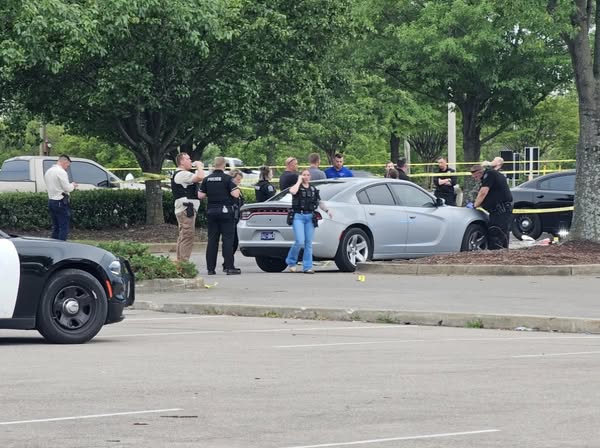On the evening of May 22, 2025, a rapidly escalating encounter outside a Walmart on Highway 64 in Bartlett, Tennessee, ended in the fatal shooting of 30-year-old Thomas Feminella. The incident, now under investigation by the Tennessee Bureau of Investigation (TBI), has reignited complex questions surrounding the use of lethal force by law enforcement in the face of unpredictable, potentially volatile public encounters. According to early reports, the sequence of events unfolded within moments—but its ramifications are certain to be dissected for months to come.
Thomas Feminella’s name was publicly released in the immediate aftermath of the shooting, and with that announcement came a host of unresolved questions. What began as a routine response to a shoplifting complaint at one of the region’s busiest retail locations—Walmart, situated at the 8400 block of Highway 64—soon turned into a fatal confrontation with irreversible consequences. While the facts available remain sparse and the investigation still underway, the official outline of events, provided by TBI and echoed by Bartlett police, begins to paint a picture of how this fatal incident occurred.
At approximately 6 p.m., officers with the Bartlett Police Department responded to the Walmart location following a call reporting shoplifting. It was during their response to this initial incident that officers encountered Thomas Feminella. According to the information released thus far, Feminella was not initially identified as the subject of the shoplifting call. However, he was reportedly seen walking away from the area on foot. Officers, perhaps noting his proximity to the scene and his departure, made the decision to approach him. What happened next would change the course of the evening—and Thomas Feminella’s life—permanently.
The Tennessee Bureau of Investigation, tasked with independently reviewing all cases of law enforcement use of deadly force in the state, reported that as officers approached Feminella, he produced a knife. He then allegedly advanced toward the officers, ignoring multiple verbal commands to drop the weapon. The details provided do not indicate how close he came to the officers or whether there was a negotiation attempt. But what is clear is that the officers felt sufficiently threatened to respond with gunfire. Two officers fired their weapons, striking Feminella near a neighboring business close to the Walmart. Emergency medical personnel were dispatched to the scene immediately following the shooting, and Feminella was transported to a nearby hospital. Despite efforts to save him, he was pronounced dead shortly after arrival.
At this time, no further information has been disclosed regarding the specific number of shots fired, the distance between Feminella and the officers at the time of discharge, or whether any body camera footage exists. In line with standard procedure, the TBI has taken the reins of the investigation and will seek to determine the legitimacy and lawfulness of the officers’ actions. This includes analyzing bodycam footage, securing physical evidence, and interviewing any available witnesses. As is customary, the agency’s findings will eventually be turned over to the appropriate district attorney’s office, which will decide whether to pursue any charges or declare the shooting justified under Tennessee law.
The officers involved in the incident have not yet been named, and it remains unclear whether they have been placed on administrative leave—a common procedural step in officer-involved shootings meant to allow for an unimpeded investigation while maintaining departmental accountability. What is also not yet clear is whether Feminella had any known criminal history, prior interactions with police, or involvement in the shoplifting incident that originally brought officers to the Walmart parking lot.
One of the more perplexing aspects of this tragedy is the apparent lack of clarity regarding Feminella’s connection to the initial theft report. Was he indeed a suspect in the shoplifting? Was he merely a passerby whose behavior raised suspicion? Or did he become agitated or defensive for reasons unknown when approached by law enforcement? The current timeline of events suggests that whatever his role in the initial theft, his later behavior—a confrontation with a knife—played a more decisive role in the incident’s outcome.
What remains to be fully understood is Feminella’s state of mind during the altercation. Law enforcement narratives of such events are often shaped by official reports that emphasize the threat perceived by officers. However, it is not uncommon for investigations to later reveal contributing factors such as mental illness, substance use, or even misunderstanding. These nuances are crucial in forming a complete and just analysis of what transpired.
The use of lethal force by police in the United States has long been the subject of scrutiny, and Tennessee is no exception. According to the Washington Post’s database on police shootings, law enforcement officers in the United States fatally shoot more than 1,000 people each year. In many cases, these shootings are later ruled justified, but they often leave communities grappling with questions of proportionality, necessity, and accountability. The Bartlett shooting fits squarely into this national dialogue.
Historically, the Tennessee Bureau of Investigation has been entrusted with conducting impartial, fact-driven investigations into officer-involved shootings. Their methodology includes thorough forensic review, ballistic analysis, and the retrieval and examination of digital evidence, such as surveillance and body camera footage. Witness interviews also play a critical role, particularly when third-party accounts differ from official narratives. In this case, TBI investigators have encouraged any bystanders who may have witnessed the incident or captured it on video to come forward—an indication that they are working to secure as comprehensive a picture as possible.
Bartlett itself, a suburb on the northeastern edge of Memphis, is a largely residential community known for its relative safety and high quality of life. With a population of just under 60,000, the city has not been a frequent flashpoint in discussions around police use of force. However, like all American municipalities, it is not immune to the broader national tensions between communities and police. When a shooting like this occurs, particularly in a public space like a Walmart surrounded by other businesses and frequented by families, the ripple effects are significant.
The immediate aftermath of the shooting caused disruptions not only at the Walmart where it occurred but also in surrounding businesses, many of which were forced to close temporarily while police secured the scene. The sense of shock among shoppers and employees is undeniable. Few expect to witness a fatal police encounter while running errands. It is unclear how many people witnessed the shooting directly, but that number could rise as investigators gather more information.
Community responses to the shooting have, as expected, been mixed. While some residents have voiced support for law enforcement and expressed concern about the dangers officers face daily—especially when confronting potentially armed suspects—others have questioned whether the use of lethal force was truly necessary. Did the officers have non-lethal options available? Was de-escalation attempted thoroughly before shots were fired? And should different protocols be in place when engaging with individuals suspected of minor, non-violent crimes like shoplifting?
While these questions are important, answers may not be available for weeks or even months. The pace of independent investigations, particularly when they involve body camera analysis and forensic review, is methodical by design. And though the TBI has pledged transparency, the agency traditionally does not comment in detail on active investigations, which can frustrate the public’s appetite for immediate clarity.
Further complicating the picture is the lack of publicly available information about Thomas Feminella himself. Beyond his name and age, little is known. The TBI has not indicated whether he had any outstanding warrants, a criminal record, or a documented history of mental illness. Without those details, understanding his actions—and whether they were deliberate, erratic, or driven by crisis—remains speculative.
This case may yet hinge on the availability and content of body camera footage. In many recent police-involved shootings across the U.S., bodycam videos have either substantiated officers’ claims or raised serious doubts. The presence—or absence—of such footage here could significantly influence both public perception and legal interpretation of the event. If footage exists, its release will likely be a major point of contention between transparency advocates and authorities seeking to protect the integrity of the investigation.
Legal experts familiar with Tennessee statutes on police use of force note that officers are generally permitted to use deadly force if they believe they are in imminent danger of death or serious bodily harm. However, whether that belief was reasonable given the specific circumstances of the Feminella shooting is the crux of the TBI’s probe. The legal standard, often referred to as the “objective reasonableness” test established by the Supreme Court’s Graham v. Connor decision, will be central in assessing the officers’ actions.
As the investigation progresses, broader discussions about policing strategies, crisis intervention, and use-of-force policy are likely to resurface. In recent years, many departments nationwide have adopted new training protocols emphasizing de-escalation, mental health awareness, and less-lethal tactics. Whether such protocols were in place or followed during the Feminella incident is another aspect that could come under review.
Civil rights groups, which often monitor such cases closely, may also weigh in once more facts are made public. Their involvement frequently brings added scrutiny to officer-involved shootings, particularly those where the suspect was not initially believed to pose a threat. Transparency, accountability, and community trust are often emphasized in their calls for reform, and it remains to be seen whether this case will ignite similar demands in Bartlett or the greater Memphis area.
For now, the name Thomas Feminella joins a growing list of individuals whose interactions with police ended in fatal force. While some may see this case as a tragic but justified response to an immediate threat, others will see it as another data point in a troubling pattern of escalation. What everyone agrees on is the need for answers—answers that the TBI investigation will eventually provide, though not quickly enough for a grieving public eager to understand how a suspected shoplifting call ended with a man dead outside a Walmart.
Until then, the memory of what happened on that Thursday evening—on the pavement near the 8400 block of Highway 64—will hang over the Bartlett community, a haunting reminder of how fast life can unravel, how fragile the line is between routine and catastrophe, and how critical it is to ensure that the systems meant to protect the public do so with both integrity and humanity.


Leave a Reply